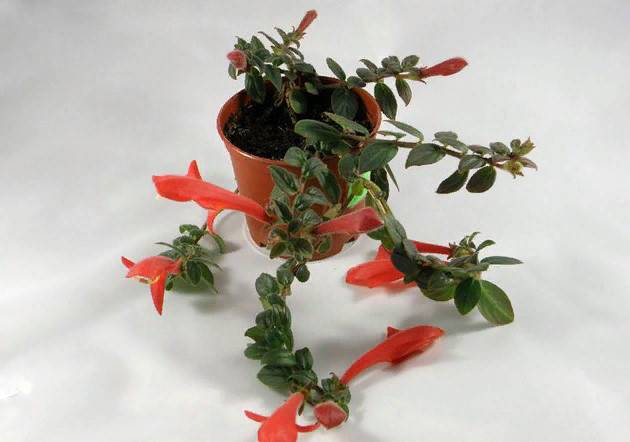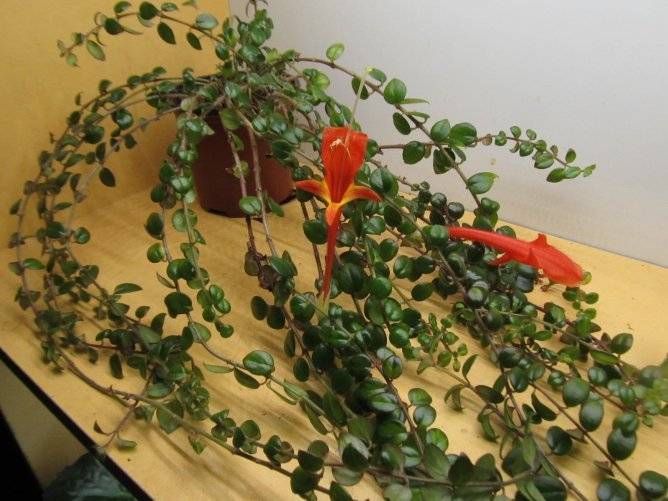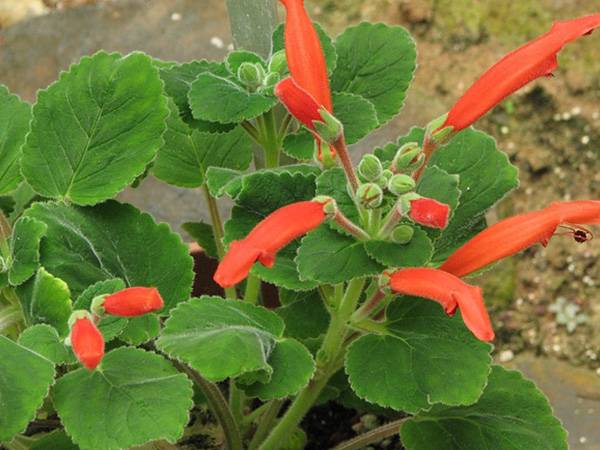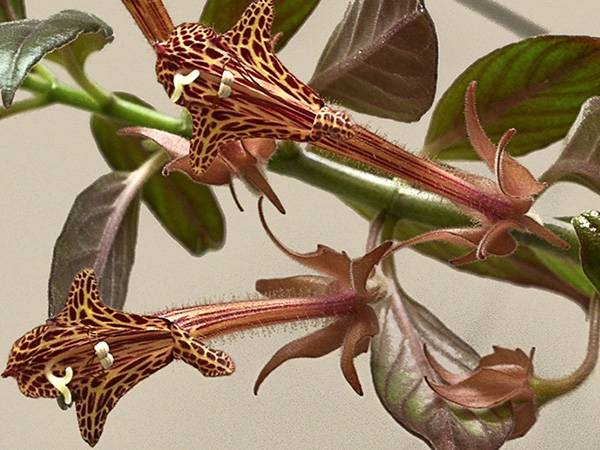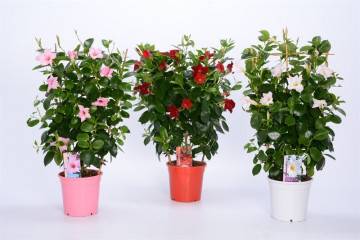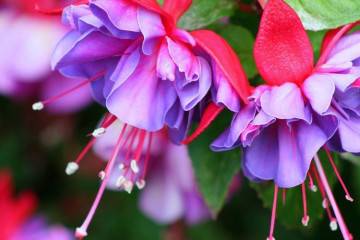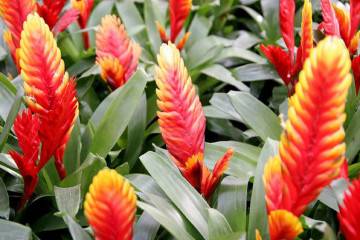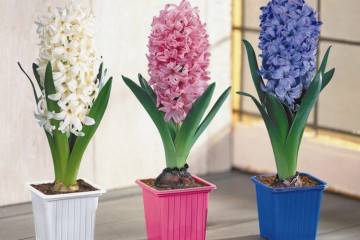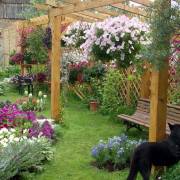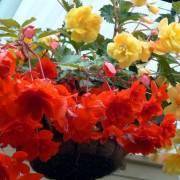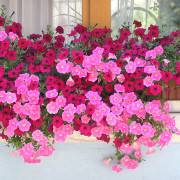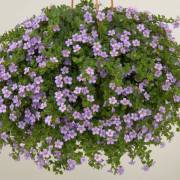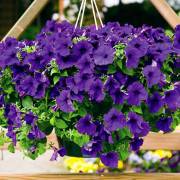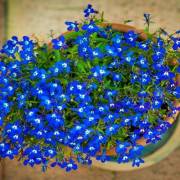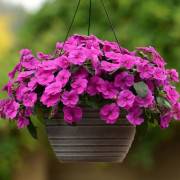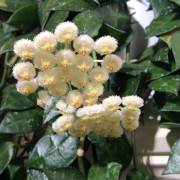Columnea - care and cultivation at home
Content:
The name of the Columbus family was given by K. Linnaeus in the 18th century. This delicate ampelous plant can be a decoration for your home or office. Columnea can impress with the unusual beauty of its flowers, while it does not require complex maintenance.
What does it look like
Columnea has flexible pubescent shoots that hang down. Smooth, dark green leaves grow on them. This plant is grown in hanging pots with the branches hanging down. Flowers grow from the axils of the leaves. They have a tubular structure. The petals in the buds are arranged in one row.
Features of home care
When a columnea is grown, home care will be simple. In order for it to develop well and bloom profusely, it is necessary to follow the relevant rules.
Temperature
Columnea is a flower that is considered to be thermophilic. However, it is not suitable for hot, but moderate conditions - 23-27 ° С. In summer, when hot and dry weather sets in, there is no need to artificially lower the temperature. This plant is able to easily tolerate short-term heat, which does not exceed 30 ° C.
Lighting
In the wild, this plant sits in the treetops under the scorching sun. In a city apartment, such conditions can be provided by placing a flower on a windowsill by a well-lit window. In this case, you need to take care that direct sunlight does not fall on the flower.
Watering
The frequency of watering is determined by the condition of the soil. The need for it arises when the topsoil becomes dry. During the summer, it is usually carried out every other day, and in the summer or autumn - once every three days.
Spraying
For the normal development of the plant, it is necessary to spray the leaves with water at room temperature. This should be done daily or at least every other day. For this, it is necessary to use settled water at room temperature.
Humidity
High humidity is favorable for flower development. To maintain it, regular spraying of the leaves is carried out.
Priming
For cultivation, you need a fertile and loose soil. You need to add a wooden substrate to it, for example, crushed bark. There should be a drainage layer at the bottom. You can buy ready-made soil for epiphytes in the store.
Top dressing
When active growth occurs, the columnea is fed twice during each month. Fertilizers with a high nitrogen content are needed in early spring. They will promote growth.
During the period when flowering occurs, the plant needs fertilizing containing a full range of essential substances.For this purpose, you can purchase fertilizer in a specialized store, which is intended for Saintpaulias.
Support
Sometimes the severity of the shoots forces the flower to bend over. In this case, you can provide them with support. You can also grow a columnea so that the shoots are located on a horizontal plane.
Transfer
The need to transplant for breeding arises in cases where the columnea has grown too much. This must be done before the onset of the dormant period or in early spring before the end of active growth.
The new pot should be 3-5 cm deeper than the roots have grown. The bottom must be covered with a drainage layer. Perlite and pieces of wood are added to the soil.
Pruning
Pinching shoots will stimulate the formation of new ones. This must be done in late autumn. During the winter, new points of plant growth are formed.
How does it multiply
Reproduction is possible using cuttings or planting seeds. However, in the latter case, it must be borne in mind that most of the varieties used are hybrids. Therefore, for their reproduction, seeds are used, which are sold by specialized stores.
Germinating seeds
To grow seedlings, you need to do the following. It is necessary to prepare a disinfected mixture of peat and sand. The seeds are placed on top, without sprinkling them. Cover the container with plastic wrap or an inverted jar. To care for them, a temperature of 23-25 ° C and daily watering are required. Usually shoots appear after three weeks. The greenhouse is then removed.
Rooting cuttings
To grow cuttings, at the end of winter, the top of the shoot is cut off with a length of no more than 10 cm. The branch must be kept in a solution of a growth stimulator. Then the cutting is planted in crushed peat.
For germination, cuttings need to ensure a constant temperature of at least 23 ° C and constantly water. After the appearance of the root system and leaves, they are ready for planting.
It is allowed to germinate cuttings by placing them in water, the depth of which should not exceed 2 cm.
Dormant period
At the beginning of autumn, the indoor flower kolumnea must be accustomed to a gradual decrease in temperature. To do this, during the day, she is taken out into the fresh air. This procedure must be continued for no more than a week.
After that, you should provide the flower with a temperature of 16 ° C and maintain it until spring comes. At this time, the plant needs rest. During the winter period, when caring for a columnea, watering must be reduced and fertilized must be stopped.
Possible problems
Sometimes it happens that a flower does not please the eye with its buds. The reasons why the columnea does not bloom:
- with a lack of lighting, the columnea will have a weak flowering. In this case, shoots will grow excessively;
- when it grows, the inner part of the flower will not grow well. In this case, it is recommended to plant the plant.
Pests
The appearance of a spider mite leads to yellowing, and then leaf fall. It can be detected by the presence of small cobwebs. Treatment is carried out by spraying with special preparations.
Diseases
If excessive watering occurs, gray mold disease is possible. Because of it, gray spots are formed on the stems and leaves. The affected areas must be removed, and the plant must be treated with an antifungal agent.
Common varieties
The genus Columbus includes hundreds of species and varieties. Of these, no more than 30 can be grown at home. Below are the most popular varieties of columnea.
Columbus Carnival
This variety has thin shoots that hang down. They are covered with small elastic leaves on short stalks. The leaves may have a smooth or fleecy surface with reddish pubescence. Columnea Carnival has large yellow flowers, and the petals have a clearly distinguishable thin red border around the edge.
Allen
A feature of this Columnea variety is the presence of creeping shoots. They can grow up to several meters in length. The leaves are uniformly green and grow in pairs. Red flowers have pointed, elongated petals.
Columnea Krakatoa
This variety got its name because it looks like a volcano. The bush of the kolumnea Krakatoa in the process of growth rises slightly above the roots, and then the branches go down. The leaves are narrow with a smooth surface. They are dark green in color. The bright red flowers are almost the same length as the leaves.
Blood red
The flower differs in that the thickened vines rise upward during the growth process, forming a bush. This plant has large oval leaves. They grow in the sinuses one at a time, alternating. The upper part of the leaf plates is dark green in color, while chaotic burgundy spots can be seen on the lower part. The buds are strongly pubescent. They are collected in small inflorescences and have a bright scarlet color.
Banks
Its lignified shoots are up to one meter long. The leaves of deep green color have a glossy shiny surface. The flowers are orange-red in color and reach a length of 5 cm. They grow in the spaces between the leaf axils.
Columbus Argut
The leaves are pointed. Columnaea Argut shoots reach one and a half meters. Sheet plates with a shiny surface. Flowers grow in leaf axils and are arranged in small groups.
Glorious
This variety has large red or orange buds with yellow edging. Flexible shoots grow up to 90 cm. Small, fleshy, rounded dark green leaves have a slight pubescence.
Columbus Early Bird
This variety is known for its abundant and early flowering. It has fiery red flowers 5-6 cm long. At the same time, the tube has a yellow color, and on the petals of the same color there is a net.
Shida
This plant has long shoots resembling vines, covered with numerous red villi. Leaves of green saturated color on the underside have red pubescence. The plates have a lanceolate elongated shape. They can reach a length of 10 cm. The buds growing along the entire length of the shoots have a yellow tint.
Columnea can be characterized by a combination of unusual flowering and unpretentious care. This flower is not widely known in Russia, but if you choose it for home cultivation, the flower will not go unnoticed.
